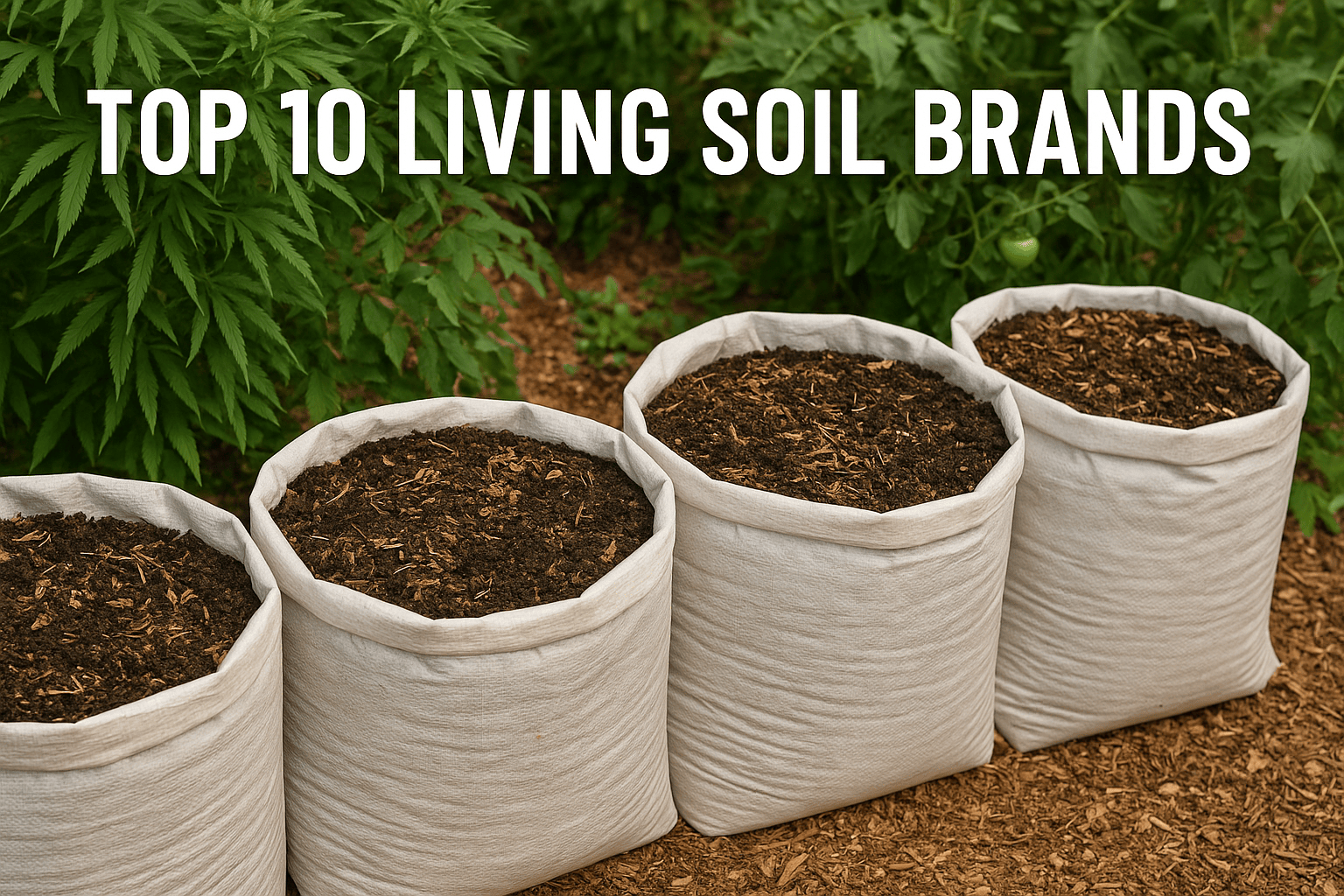
Living soil is not just dirt—it’s a thriving, dynamic ecosystem beneath your plants. In recent years, it has become a go-to choice for organic gardeners and cannabis cultivators who prioritize sustainable growing practices, microbial health, and nutrient-rich soil biology over synthetic additives. But with so many products on the market, finding the right one can be overwhelming.
That’s why we’ve created this curated list of the top ten living soil brands—each selected based on performance, microbial activity, organic content, and suitability for both indoor and outdoor grows. Whether you’re growing vegetables, herbs, or cannabis, this guide will help you choose a soil that supports vigorous plant growth, natural nutrient cycling, and maximum yield—without relying on chemical fertilizers.

In this post, you’ll discover:
- ✅ What living soil is and how it works as a complete growing system
- 🌿 The benefits of using living soil for cannabis cultivation and regenerative gardening
- 🏆 Our top 10 picks for the best living soil brands on the market in 2025
- 🧪 What criteria we used to rank each soil—such as microbial diversity, drainage, and organic inputs
- 💡 Tips for choosing the right mix for your grow setup and how to maintain it across multiple cycles
Whether you’re a first-time grower or a seasoned cultivator looking to switch to an organic soil blend, this post has everything you need to make an informed decision.
🌿 What is Living Soil?
Living soil is more than just a medium to anchor your plants—it’s a living, breathing ecosystem that fuels plant growth by mimicking nature’s own soil cycles. Unlike sterile or synthetic mixes, living soil is teeming with microbial life: beneficial bacteria, fungi, protozoa, nematodes, and other organisms that form a complex soil food web. These microscopic allies break down organic matter, releasing nutrients in plant-available forms exactly when needed.
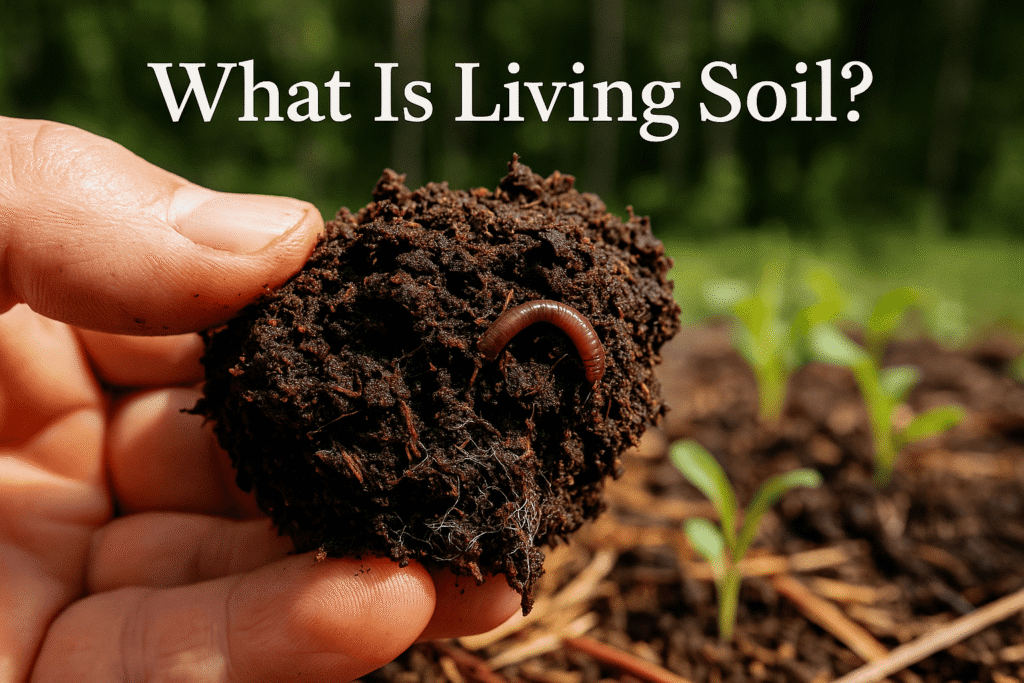
Let’s break down what makes living soil unique:
It’s a Living Ecosystem
At the heart of living soil is the microbial biomass—millions of bacteria and fungi that create a symbiotic relationship with plant roots. They decompose compost, break down minerals, and make nutrients like nitrogen and phosphorus readily available to plants. In return, plants feed these microbes through root exudates (sugary secretions).
It Contains Compost and Organic Matter
Living soil is rich in organic inputs like compost, worm castings, kelp meal, and humus. These inputs provide a steady source of slow-release nutrients and feed the microbial community, keeping your soil alive and productive throughout the grow cycle.
It Mimics Natural Soil Cycles
Nature doesn’t bottle nutrients. Instead, it relies on decomposition and biological activity to cycle nutrients over time. Living soil replicates this natural nutrient cycling, meaning you rarely need synthetic fertilizers or boosters. It’s a low-maintenance, closed-loop system.
It Improves Over Time
Unlike traditional soil that depletes after a single grow, living soil can actually get better with each cycle—especially when using no-till or recycled soil methods. With proper care (like adding compost teas and cover crops), microbial diversity increases, boosting plant health and resilience.
It’s Ideal for Organic & Cannabis Cultivation
Cannabis plants thrive in microbial-rich environments where nutrients are available in a bioactive form. Living soil enhances flavor, aroma, terpene production, and overall plant health. Many craft growers consider it the gold standard for organic cannabis growing.
Living soil isn’t just “dirt with microbes”—it’s a self-sustaining habitat that supports vigorous, healthy, and flavorful plant growth. By embracing living soil, you’re cultivating more than just plants—you’re cultivating life beneath the surface.
🌱 Why Use Living Soil in Gardening or Cannabis Growing?
Choosing living soil is like giving your plants a symbiotic support system—rooted in biology, not bottles. Whether you’re growing juicy tomatoes or terpene-rich cannabis buds, living soil creates an ideal environment for natural growth, resilience, and flavor development.
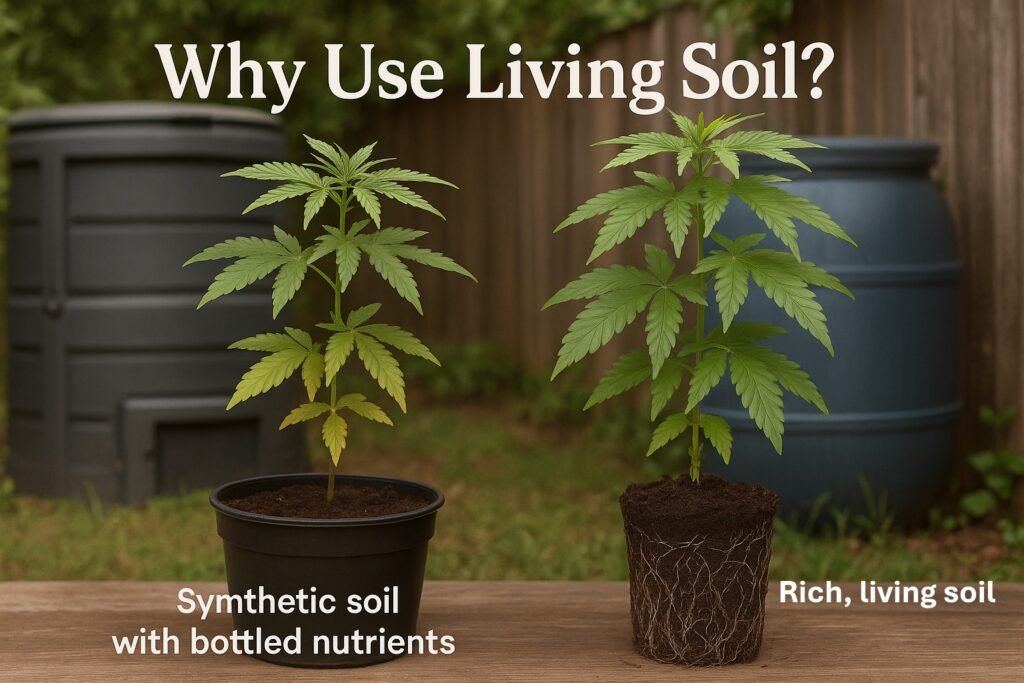
Here’s why more growers are turning to this microbial-rich growing medium:
Natural Nutrient Cycling Means Less Bottled Fertilizer
Living soil contains microorganisms that unlock nutrients from organic matter, creating a continuous cycle of nourishment. Unlike synthetic feeding schedules, living soil works with nature’s rhythm—releasing what plants need, when they need it.
- Beneficial bacteria and fungi convert organic compounds into plant-available nutrients
- Reduces or eliminates the need for synthetic nutrients or boosters
- Supports a more sustainable and low-input growing style
Healthier Root Zones and Stronger Immunity
A thriving soil food web protects plants from pathogens and environmental stress. Living soil supports better root development, aeration, and oxygen flow—all while forming protective microbial barriers against root rot and pests.
- Mycorrhizal fungi extend root surface area and enhance nutrient uptake
- Microbial competition suppresses harmful organisms naturally
- Healthier roots = stronger, more productive plants
Enhanced Flavor, Aroma & Terpene Profile in Cannabis
One of the biggest reasons living soil is favored in craft cannabis cultivation is its profound effect on terpene production. Terpenes are influenced by a plant’s nutrition and stress levels—both of which are optimized in a biodiverse, organic environment.
- Organic inputs encourage secondary metabolite production
- Balanced nutrition prevents chemical stressors that mute flavor
- More robust profiles for taste, scent, and medicinal potency
Environmentally Friendly & Regenerative
Living soil is part of a closed-loop system. By reducing chemical runoff, promoting biodiversity, and regenerating soil health each season, it supports eco-conscious growing that works with—not against—nature.
- No synthetic chemicals leaching into groundwater
- Supports pollinators and soil biodiversity
- Compatible with no-till and permaculture practices
Cost-Effective Over Time
While the initial cost of a premium living soil blend may be higher, the long-term savings are real. With minimal need for bottled nutrients, pest control, or repeated soil purchases, living soil systems pay for themselves with repeated use and high yields.
- Reusable across multiple grow cycles with recharging
- Fewer products required for nutrient management
- Increases ROI for both home growers and small farms
Criteria for Ranking the Best Living Soil Brands
When evaluating and recommending the top living soil brands, we didn’t just rely on popularity or marketing claims. We focused on what truly matters for healthy plant growth, microbial diversity, and long-term soil performance. Whether you’re growing organic vegetables or premium cannabis, the right soil blend makes a world of difference.

Below are the key criteria we used to rank each brand, based on expert grower insights, user reviews, and biological benchmarks.
Microbial Activity & Soil Life
At the heart of any good living soil is its microbial community. Brands that support active colonies of beneficial bacteria, mycorrhizal fungi, and protozoa naturally enhance nutrient uptake, disease resistance, and soil structure.
- High counts of active microbes (not just dormant spores)
- Presence of compost, worm castings, and fungal inoculants
- Compatibility with compost teas and microbial additives
Organic Certification and Input Quality
Top-tier living soils are made with OMRI-listed or certified organic inputs. This includes plant-based compost, fish meal, kelp, alfalfa, and humus that feed the soil biology and provide slow-release nutrients.
- Use of clean, pesticide-free compost and amendments
- Organic labeling and transparency in sourcing
- No synthetic fertilizers, pesticides, or fillers
Water Retention and Aeration
An ideal living soil retains moisture without waterlogging and allows for ample oxygen to reach the roots. A mix that includes perlite, pumice, or rice hulls balances drainage and airflow—essential for both microbial life and root development.
- Light, fluffy texture that encourages root growth
- Excellent drainage to prevent anaerobic conditions
- Ability to hold moisture evenly across grow cycles
Customer Reviews and Grower Success Stories
Real-world results matter. We considered how each soil performs across various environments—from indoor tents to outdoor gardens—and how it’s rated by both novice and professional growers.
- Positive testimonials from cannabis and organic growers
- Consistent performance across grow cycles
- High ratings on grow forums, YouTube, Reddit, and Amazon
Top 10 Living Soil Brands on the Market
After comparing dozens of living soil mixes on the market, we’ve selected the top 10 living soil brands that stand out in terms of microbial richness, organic inputs, drainage, and real-world grower results. Each brand listed below is well-suited for cannabis cultivation, organic gardening, or regenerative farming.
Below, you’ll find detailed descriptions with pros, cons, and what each mix is best used for.
1. BuildASoil Craft Blend Living Soil
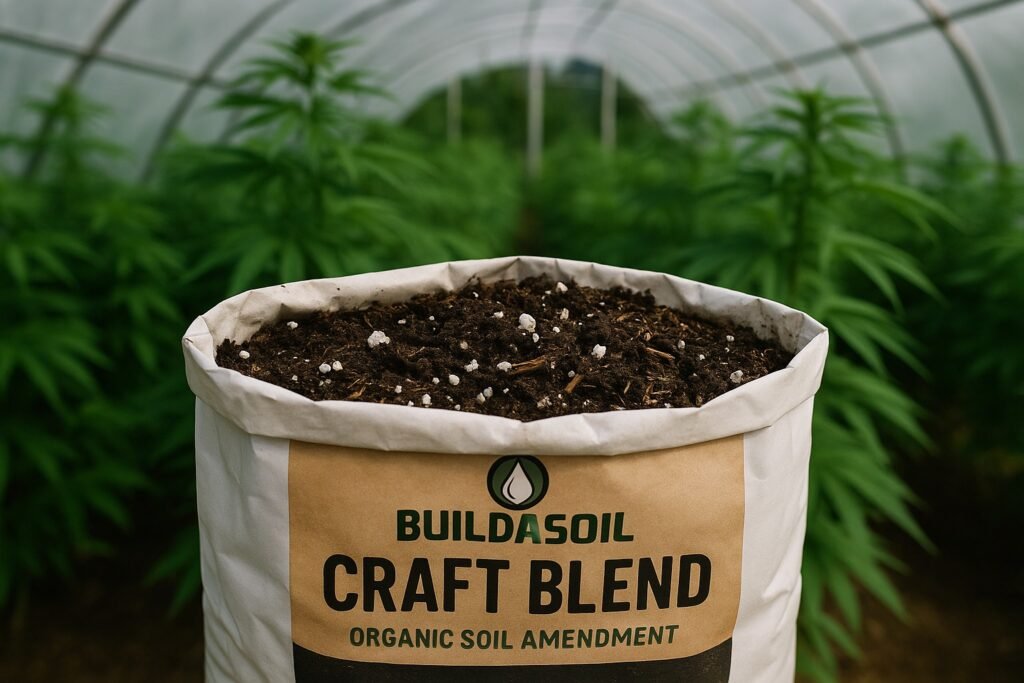
BuildASoil is a top name in the DIY organic grower community, known for its transparency, quality inputs, and customizability. Their Craft Blend Soil is packed with minerals, compost, worm castings, and organic amendments that support a thriving soil food web.
This living soil is ideal for experienced growers who like to build or tweak their own mixes. It’s a “water-only” solution for much of the grow cycle, meaning you won’t need bottled nutrients—just microbes, compost teas, and the right environment.
2. Sohum Living Soils
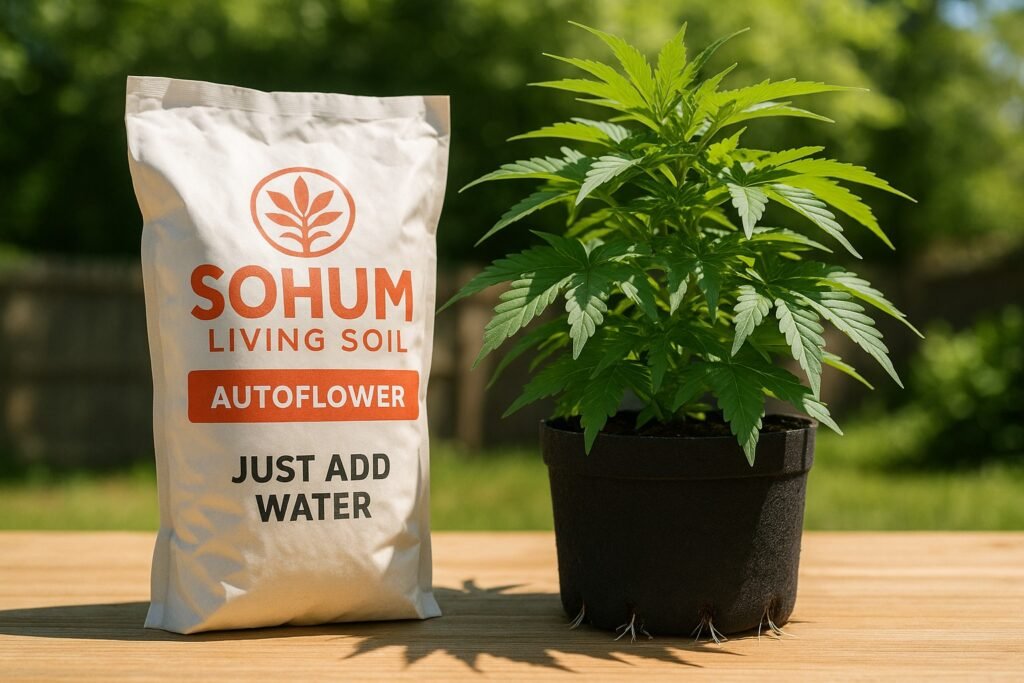
Sohum Living Soil is a ready-to-use, all-in-one mix designed for growers who want simplicity without sacrificing quality. It’s a water-only soil enriched with mycorrhizae, organic nutrients, and composted inputs.
Sohum is widely recommended for beginners because of its ease of use—it doesn’t require pH adjustments or bottled nutrients. It’s especially well-suited for autoflowering cannabis strains and vegetable container gardening.
3. Coast of Maine Stonington Blend

Coast of Maine’s Stonington Blend is a rich, aerated soil designed for container growing, including cannabis. With inputs like fish bone meal, worm castings, kelp meal, and lobster compost, this mix feeds both your plants and the microbial community.
Growers appreciate its heavy nutrient load and fluffy texture, which allows for optimal drainage and oxygen flow. It’s particularly effective during vegetative growth and early flower stages.
4. Purple Cow IndiCanja
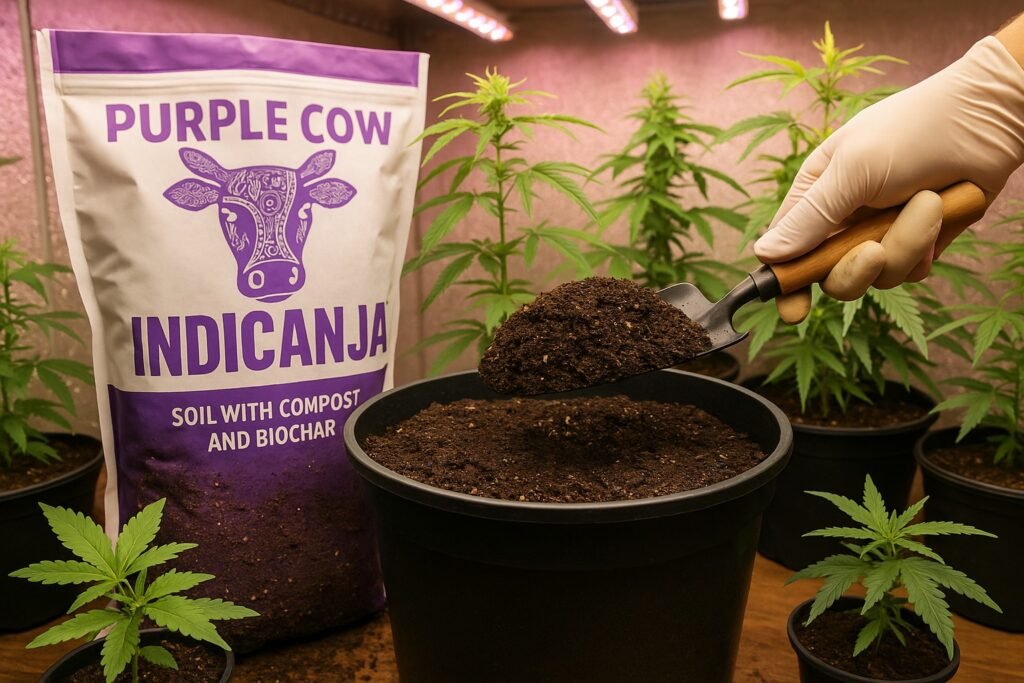
Purple Cow IndiCanja is an organic, pre-charged soil created with cannabis specifically in mind. It features a unique blend of compost, peat, biochar, and plant-based inputs. It’s designed to support the entire life cycle of cannabis plants from seedling to harvest.
IndiCanja has a balanced N-P-K ratio, making it especially popular for indoor cannabis growers and autoflower cultivators. The inclusion of biochar enhances nutrient holding capacity and microbial colonization.
5. Gaia Green Living Soil

Gaia Green Living Soil is built on the brand’s reputation for high-quality organic amendments. This soil mix combines premium compost, peat moss, perlite, and slow-release dry amendments—making it especially well-suited for growers who prefer super soil-style gardening.
With a balanced nutrient profile, Gaia Green soil provides a strong start in the vegetative phase, but may need additional top dressing or compost teas for heavy-feeding cannabis plants later on. It’s a great base mix for building long-term regenerative beds or containers.
6. KIS Organics Water Only Soil
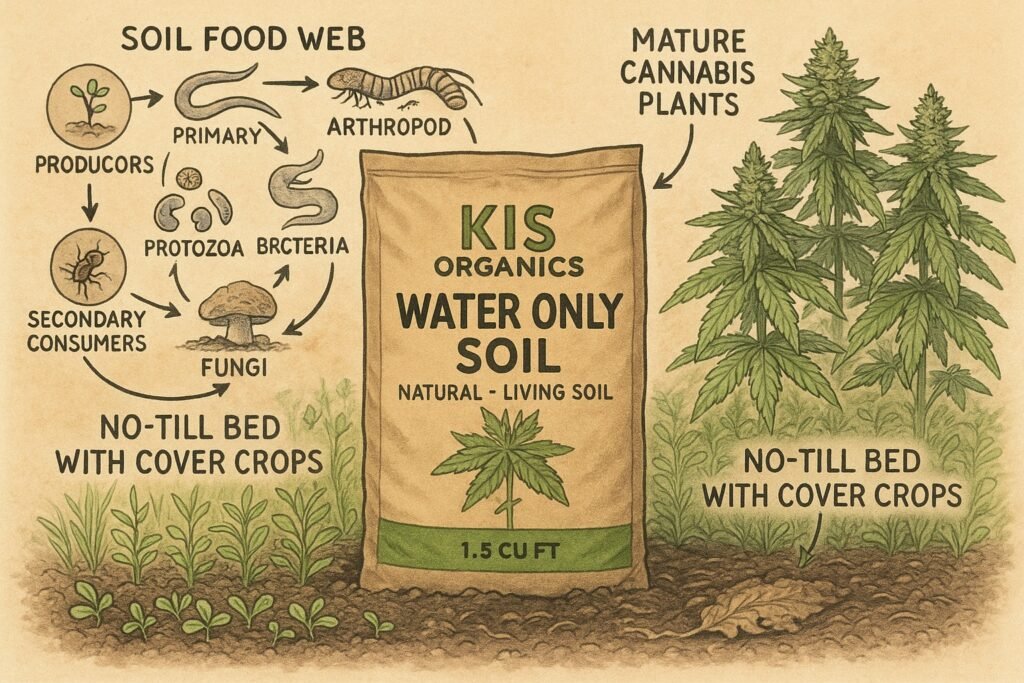
KIS Organics offers a high-performance Water Only Soil Mix, designed for serious growers who want maximum microbial activity and no synthetic input reliance. It includes thermophilic compost, lava rock, biochar, and a broad-spectrum nutrient charge.
KIS Organics is known for its scientific approach to soil biology. Their soil is lab-tested for microbial life and fungal-to-bacteria ratios, making it ideal for no-till systems and living bed environments. It’s widely used in both indoor and outdoor commercial organic grows.
7. Michigan Made Mix

Michigan Made Mix has earned cult status in the cannabis growing community, especially among Midwestern growers. It’s a locally produced living soil with rich compost, worm castings, and hand-blended organic inputs, offering exceptional root support and vibrant flowering.
Growers report robust results in flowering stages, making it an excellent choice for photoperiod strains. While it doesn’t carry a national certification, it’s trusted for its consistency and real-world results.
8. Great Lakes Water Only Soil
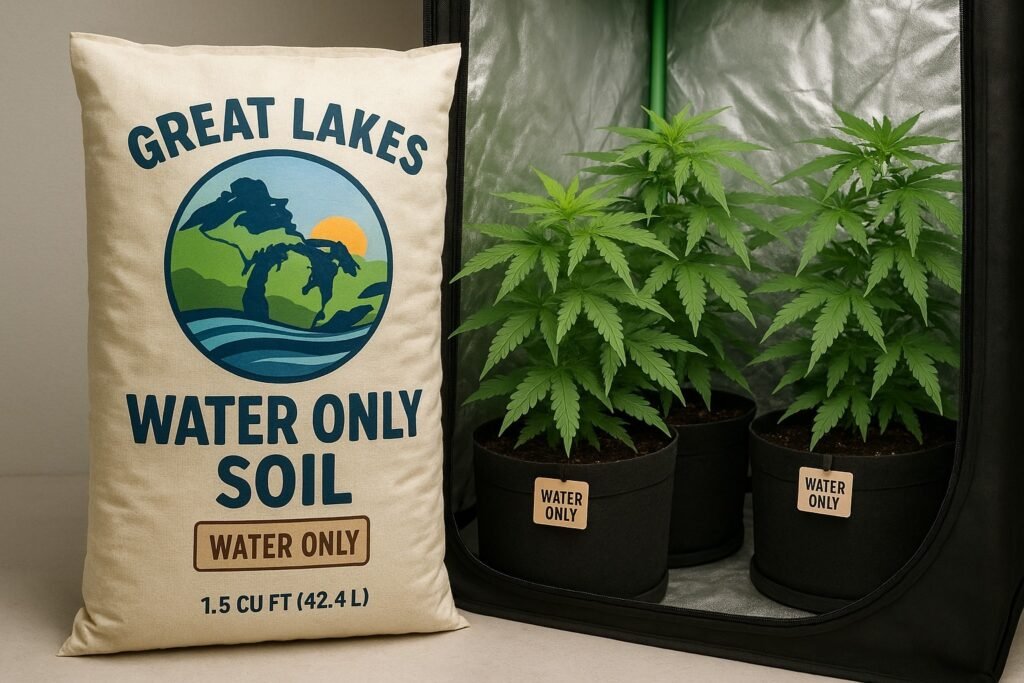
This is another Midwest favorite, specifically formulated for water-only growing. Great Lakes Water Only Soil includes compost, peat, worm castings, and a nutrient blend to take plants from seedling to harvest without bottled supplements.
Ideal for beginners and small home grows, this soil delivers consistent results with minimal input. It’s especially effective for container cannabis cultivation, thanks to its balanced moisture retention and drainage.
9. Malibu Compost Bu’s Blend Biodynamic Compost

While not a traditional living soil, Malibu Compost’s Bu’s Blend is a premium biodynamic compost used to build custom living soil mixes. It features manure from pasture-raised cows, organic straw, and biodynamic preparations that enrich microbial life.
Ideal as a soil amendment or base layer, this compost is used by regenerative farmers and small-batch cannabis growers looking for microbial richness and soil vitality. It’s best paired with aeration components and mineral inputs.
10. Nature’s Living Soil Autoflower Concentrate
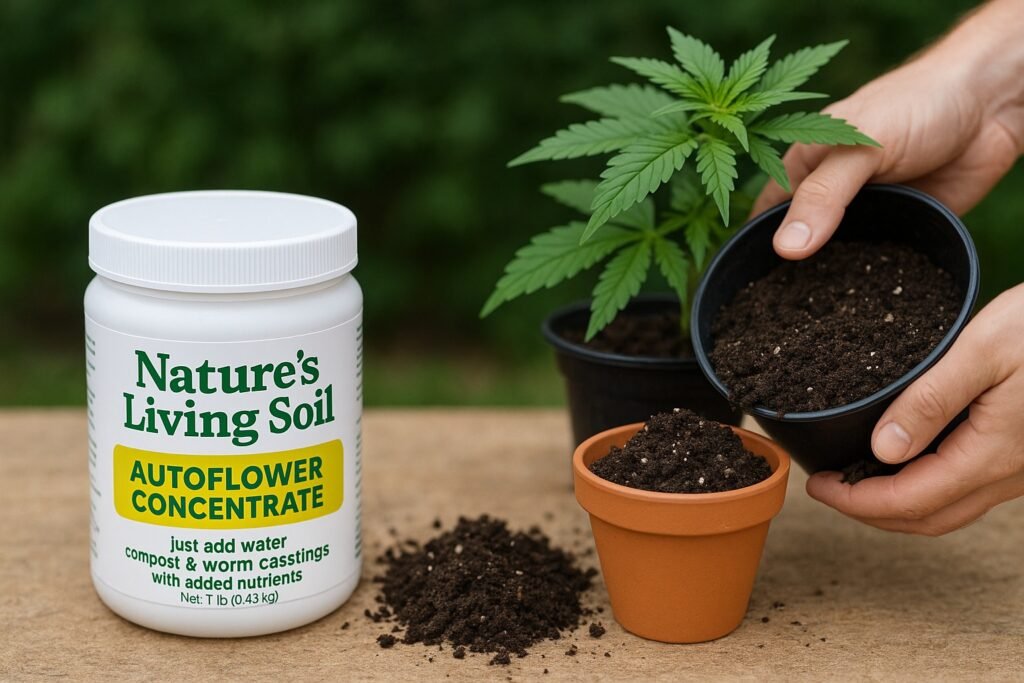
Nature’s Living Soil Autoflower Concentrate is specifically designed for the shorter life cycle and unique needs of autoflower cannabis strains. It’s not a ready-to-use soil, but a concentrated amendment to mix into a base like coco coir or potting soil.
This mix includes humic acids, bat guano, fish bone meal, and beneficial microbes—creating a nutrient-dense zone for young plants that grows with them. It’s ideal for indoor, small-pot setups.
How to Choose the Right Living Soil for Your Grow
With so many living soil brands and custom blends available, choosing the best one for your specific grow setup can feel overwhelming. The right soil will depend on your grow style, plant type, and how involved you want to be in managing nutrients. This guide will help you align your soil choice with your cultivation goals—whether you’re growing cannabis, vegetables, or herbs in an indoor tent, outdoor bed, or container system.
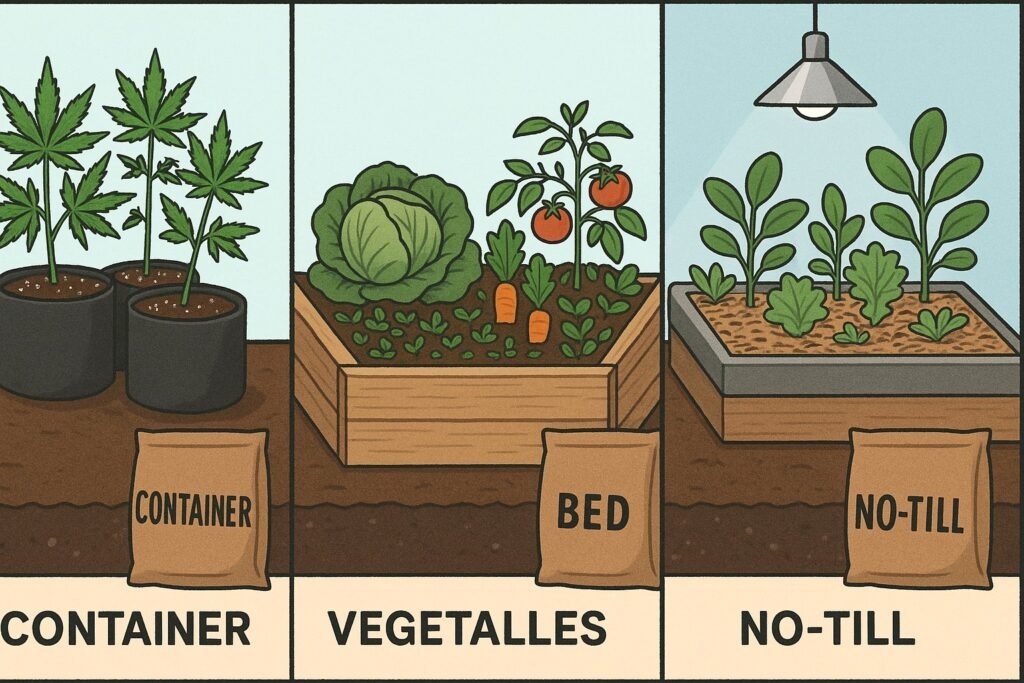
Grow Style: Container, Bed, or No-Till Setup
Different setups require different soil textures and microbial profiles. If you’re growing in fabric pots or containers, prioritize aeration and drainage. Raised beds may benefit from heavier soils that retain moisture, while no-till gardens thrive on long-term microbial activity and soil regeneration.
- Container Growers: Look for light, fluffy mixes with perlite or pumice (e.g., Sohum, Great Lakes Soil)
- Raised Beds: Choose nutrient-rich, compost-dense blends (e.g., Stonington Blend, Michigan Made Mix)
- No-Till Systems: Go for biologically active, rechargable soils like BuildASoil or KIS Organics
Match the Soil to Your Plant Type
Cannabis, tomatoes, leafy greens, and root vegetables all have different nutrient needs. Cannabis, in particular, requires a well-balanced NPK ratio and a healthy rhizosphere for terpene and resin development.
- Cannabis: Choose soils with microbial inoculants, organic inputs like fish bone meal, and solid fungal content (e.g., IndiCanja, Gaia Green)
- Vegetables & Herbs: Compost-heavy soils with worm castings and kelp meal work well
- Autoflowers: Use lightweight, concentrated amendments like Nature’s Living Soil or Sohum for faster grow cycles
DIY vs. Pre-Mixed Living Soils
Some growers enjoy crafting their own custom mixes, while others prefer ready-to-use living soil products that require minimal work. Your experience level and time commitment will help determine which route is best.
- DIY Growers: BuildASoil Craft Blend and Malibu Compost are ideal for custom layering and experimenting
- Hands-Off Growers: Sohum and Purple Cow IndiCanja offer plug-and-play solutions for all-in-one growing
- Intermediate Users: Mix concentrates like Nature’s Living Soil into a base for semi-custom setups
Tips for Maintaining and Reusing Living Soil
One of the biggest advantages of living soil is its ability to be reused and improved over time. Unlike synthetic soils or depleted commercial mixes, well-maintained living soil becomes more biologically diverse, more nutrient-rich, and more resilient with each grow cycle.

However, reusing living soil successfully requires some care. Below are essential tips to help you recharge, revitalize, and preserve the microbial ecosystem that makes your living soil so powerful.
Recharging Soil After Each Harvest
After a harvest, your soil has likely expended a portion of its nutrients and may have undergone compaction. Recharging helps restore balance and fuel microbial regeneration.
- Top dress with worm castings, compost, or dry amendments (e.g., kelp meal, alfalfa meal, neem cake)
- Add fresh microbial inoculants or compost teas to repopulate the rhizosphere
- Aerate the top layer to prevent compaction and increase oxygenation
When and How to Add Compost Teas or Top Dress
Compost teas are microbial brews that reintroduce beneficial bacteria and fungi. They can be applied as a drench or foliar spray to jumpstart microbial life in tired or reused soils.
- Apply teas during veg phase or after transplant for best results
- Top dress dry amendments every 3–4 weeks to replenish key nutrients
- Use EM-1 or lab-based microbe cultures for targeted microbial boosts
Avoiding Salt Build-up and Compaction
Even organic inputs can lead to salt accumulation over time if soil is not flushed or allowed to rest. Compaction is another threat to living soil health, as it reduces oxygen flow and microbial movement.
- Use plain water flushes between grows (avoid heavy runoff in no-till setups)
- Incorporate aeration materials like rice hulls or pumice if structure breaks down
- Rotate crops or add cover crops to break up compact layers naturally
Store Soil Properly Between Grows (If Needed)
If you’re taking a break between grows, don’t let your living soil dry out and die. Store it correctly to preserve microbial viability and soil moisture balance.
- Keep soil in breathable containers like fabric pots or tubs with airflow
- Maintain slight moisture (not soaking) and cover with straw or mulch
- Optionally add some EM-1 or worm castings during storage for microbial insurance
FAQs
Absolutely. Living soil is excellent for indoor growing, including grow tents and greenhouses. Just make sure you use a well-aerated mix and monitor humidity and watering carefully, since indoor environments lack natural airflow and evaporation. Choose water-only mixes like IndiCanja or Sohum Living Soil for ease and consistency.
If properly maintained, living soil can last for years. Its microbial community grows stronger over time, especially in no-till setups or reused containers. You’ll need to recharge the soil between cycles using top dressings, compost teas, and organic matter, but the core structure can remain productive long-term.
That depends on your goals. Hydroponics can offer faster growth and precise control, but living soil produces richer flavors, higher terpene content, and a more natural plant development process. It’s also more sustainable and eco-friendly. For growers focused on quality and organic standards, living soil is often the better choice.
Autoflowers prefer lighter soils with balanced nutrients and a good ratio of aeration to moisture retention. Pre-blended options like Sohum Living Soil or Nature’s Living Soil Autoflower Concentrate are ideal. These provide the nutrients autoflowers need without overwhelming them during their rapid life cycle.
Yes! You can create your own DIY living soil using compost, peat moss or coco coir, perlite, worm castings, and dry amendments like kelp meal or alfalfa meal. Adding mycorrhizal fungi and using compost teas will help activate the microbial life. Brands like BuildASoil and Malibu Compost offer great ingredients for custom blends.
Final Thoughts
Choosing the right living soil is more than just selecting a bag of dirt—it’s about investing in a thriving, self-sustaining ecosystem that will support your plants for multiple cycles. Whether you’re cultivating organic vegetables, crafting top-shelf cannabis, or building a regenerative garden, the soil beneath your plants is where true health begins.
Throughout this guide, we’ve explored the top ten living soil brands—each offering unique blends designed to nourish the soil food web, promote natural nutrient cycling, and eliminate the need for synthetic fertilizers. We also broke down how to pick the right soil for your grow style, and how to maintain it over time through recharging, top dressing, and compost tea applications.
Ultimately, the best living soil is the one that aligns with your growing goals, resources, and philosophy. With a proper foundation and consistent care, your living soil will not only yield better plants—it will get stronger and more productive with each season.
So whether you’re a home grower with a couple of pots or a no-till gardener running a full living bed, remember: feed your soil, and it will feed your plants.
What Is Live Soil?





